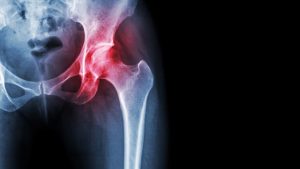A Hip Replacement is sometimes recommended for advanced arthritis that does not respond to nonoperative treatments. The worn-out parts are usually replaced by components made of ceramic, metal, and plastic. These parts function very well to restore function, improve motion, and decrease pain.
Causes of Hip Arthritis
The most common cause of chronic hip pain and disability is arthritis. The pain and lack of motion associated with hip arthritis can present as knee pain and worsen back pain due to altered body mechanics.
- Osteoarthritis – This is an age-related “wear and tear” type of arthritis. It usually occurs in people 50 years of age and older and often in individuals with a family history of arthritis. The cartilage cushioning the bones of the hip wears away. The bones then rub against each other, causing hip pain and stiffness. Osteoarthritis may also be caused or accelerated by subtle irregularities in how the hip developed in childhood.
- Rheumatoid arthritis – This is an autoimmune disease in which the synovial membrane becomes inflamed and thickened. This chronic inflammation can damage the cartilage, leading to pain and stiffness. Rheumatoid arthritis is the most common type of a group of disorders termed “inflammatory arthritis.”
- Post-traumatic arthritis – This can follow a serious hip injury or fracture. The cartilage may become damaged and lead to hip pain and stiffness over time.
- Avascular necrosis – An injury to the hip, such as a dislocation or fracture, may limit the blood supply to the femoral head. This is called avascular necrosis (also commonly referred to as “osteonecrosis”). The lack of blood may cause the surface of the bone to collapse, and arthritis will result. Some diseases can also cause avascular necrosis.
- Childhood hip disease – Some infants and children have hip problems. Even though the problems are successfully treated during childhood, they may still cause arthritis later on in life. This happens because the hip may not grow normally, and the joint surfaces are affected.
Description of the Procedure
In a total hip replacement (also called total hip arthroplasty), the damaged bone and cartilage is removed and replaced with prosthetic components.
- The damaged femoral head is removed and replaced with a metal stem that is placed into the hollow center of the femur. The femoral stem may be either cemented or “press fit” into the bone.
- A metal or ceramic ball is placed on the upper part of the stem. This ball replaces the damaged femoral head that was removed.
- The damaged cartilage surface of the socket (acetabulum) is removed and replaced with a metal socket. Screws or cement are sometimes used to hold the socket in place.
- A plastic spacer is inserted between the new ball and the socket to allow for a smooth gliding surface.
Recovery from Hip Replacement

Hip replacement surgery generally takes 1½ to 2 hours in the operating room. Directly following the surgery, the patient is brought to a recovery room where vital signs are monitored. Once the patient has been stabilized, he/she can move out of the recovery room.
Physical Therapy Protocols
- Physical therapy – During the first few weeks of physical therapy, some degree of discomfort and stiffness is expected. As the therapy continues, your body will adjust to the new prosthetic, allowing it to operate as part of your leg. Even after physical therapy is concluded, the knee needs to continue being active. Walking or other mild activities are perfect to increase mobility over time. It may take 12-18 months for your muscles to fully strengthen.
- Incision care – A sterile dressing will be applied in the operating room. If dry, this dressing will often remain for 1-2 weeks. Afterwards, it can be removed and covered with a dry dressing. You must keep the incision dry for the first 10-14 days. Do not soak the hip for 4 weeks after surgery.
- DVT prophylaxis – Lower extremity surgery poses an increased risk for blood clots. In mobile patients, Aspirin 2x/day for 4 weeks will thin the blood enough to minimize this risk. In patients with a history of clotting, decreased mobility, or GI issues, alternatives such as Eliquis, Lovenox, Xarelto, or Coumadin will be prescribed.
- Follow-up – For the first year following surgery, scheduled follow-up appointments will ensure that recovery is going as planned. We would like to see you at 2 weeks, 6 weeks, 3 months, and one year after your surgery. After that, annual visits may be expected to keep your knee in peak condition.
